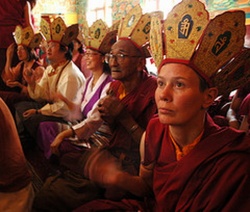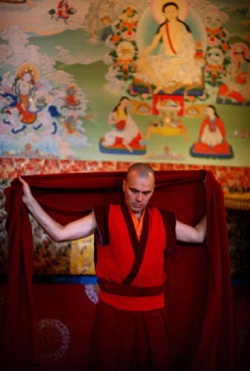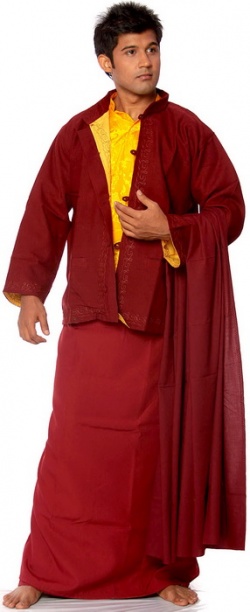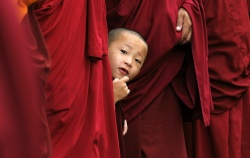Tibetan Buddhist Monk Robes for Men & Women
Many people wonder about the Tibetan monks and their robes. Different on its own, colorful and eye catching, but hard to understand what they mean.
The Buddhist robes or Tibetan robes are a part of 2500 years old tradition, dating back to the time of Siddhartha Gautam who would be Gautam Buddha later. Origin of these robes leads us back to the days when first monks in the time wore clothes made of rags, as many other holy men in Indian subcontinent did. As the popularity of Buddhism grew more and more men/ monks started using these robes and Buddha himself felt a necessity to set some rules about the robes; or so some of the holy books in Buddhism say. The discipline of robes is recorded in Vinayap-pitika of Pali Canon or Tripitika; one of the major books in Buddhism that has a huge amount of philosophy and instructions about Buddhism and its ways.
History and origin
Encountered with sickness, death and old age, young Siddhartha Gautam was forced to ask himself questions about his knowledge, privilege and assumptions of life. As the legend goes, he relinquished his home, family, luxurious life and devoted his remaining life in the search of answer for the questions like suffering in life, birth and death and old edge. In order to do so he traded his belongings with traders, including his royal clothes with what he thought was the simplest of all, beggar’s clothes.
Now the question arises, did really Buddha looked liked a beggar when he went for meditation? If yes, than why aren’t there any recorded evidence of it. Why all the Buddha’s Thangka Paintings, images and statues have nice clothing on them? Although the myths tell us that he traded his clothes for the ones like beggar; it’s pretty obvious that he was looking after something simple. Or there might be another assumed answer for the questions. May be he lived and meditated wearing beggar like clothes. But when he attained enlightenment, he got followers and attendants; he was replenished by donations and helps. And that’s when people came to know about Buddha, and that’s why modern images or statues of Buddha do not have looks of Buddha in ragged clothing. Anyways, the very concept of robes in Buddhism emerged from an inspiration of living a simple life.
Here is what sutra and ancient parchment of Buddhist religion tells us about the Tibetan Monk robes. They were made from discarded scraps of cloth called pamsuda or pamsula in Sanskrit. A piece of cloth must have some properties to be a pamsuda or pamsula. Burned by fire, chomped by oxen, cut my mice, worn by dead etc are some of their properties. These kinds of clothes were scavenged from different places and then used after proper cleaning and sewing.
History says, it was king Bimbasara who suggested Lord Buddha to make distinctive robes for his followers. Then Buddha asked one of his attendants, to design a robe. It is believed that, after this Buddhist robes came to existence. Twenty five hundred years have passed and Tibetan monk robes or Buddhist robes have been brought to style and is still in use and trendy.
About the clothing
The original Busddhist robe is comprised of three parts, in layered fashion depending upon the activities a monk does and weather. This three layered robes is known as “triple robe” or TRICIVARA in Sanskrit. Here are the three layers of the Tibetan monk robes with description:
a. Uttarasanga: Uttarasanga is a normal clerk like robe. A large rectangle robe that is about nine feet in length and six feet in width, this is worn wrapped around the body covering both the solders. This is called the kashaya robe. Though all three robes are made of kashaya fabrics, Uttarasanga was what represented Buddhism as it spread other countries and got its name Kashaya. It is consists of five-column field, bordered by rice field pattern, which is widely regarded as the symbol of buddhist’s relationship with Lord Buddha and his teaching.
b. Antarasavaka: This is the lower lobe. It’s wrapped around the waist to the knee like sarong and it is tied at the waist with a cotton belt. Accorgint to the monastic discipline of vinaya, a monk is allowed to use Antarasavaka if he is on his own or sick or while crossing the river and if he is looking for a new Uttarasanga.
c. Sanghati: Sanghati is an extra robe, which is often made of two layers, generally used for extra warmth in the cold regions. This can be used as a bedding while sleeping or as a spread out while sitting. It is seen on monks shoulder folded.
This “triple robe” or TRICIVARA spread around the world as Buddhism got popular.
Colors and Types of Robes
Though the robes worn by monks around the world vary by great deal, Tibetan Buddhist monks use most elaborate Buddhist robes. These Tibetan robes tend to be very colorful and flamboyant. Tibetan Buddhist monks usually wear robes made of crimson pulu. In daily life, a monk normally wears a shawl over a decorated yellow (often golden colored)cloth, a long skirt for the lower part of the body with a drape that is almost two and half the times if the body length. When a monk attends religious meeting, he wears a cloak and a special yellow cap, rising high above the head, which is nicely sewed and looks like a roosters comb. This doesn’t apply for all the monks, dressing might vary depending upon the rank (sect) of a monk. The most universal way a Tibetan monk wears a robe is by wearing the robe alms- round and the robe covering both arms. Top two corners of the robes are held together and the edges are rolled tightly. The roll is than pushed over the left shoulder, under the armpit and is pressed down the left arm.
The basic robes that Tibetan Monk wear consists of following parts:
1. The Dhonka: Dhonka is a wrap shirt with cap sleeves, which is either completely maroon or mixture of yellow and maroon with blue piping.
2. The Shemdap: Shemdap is a maroon colored long skirt used for covering the lower part of the body. This is made with patched clothes and various pleats.
3. The Chogu: This is another wear similar to sanghati, made of patches and worn in the upper body.
4. The Zhen: This is similar to the chogu, but maroon in color and used as a day to day wear.
5. The Namjar: This is a bit larger than chogu, but more patches and golden or bright yellow in color, made of silk. It is only used for the ceremonial occasions.
Materials and coloring of the robes
As per the discipline of the Pali tradition, only six kinds of clothes must be used to make the upper and outer robes; namely fibers, cotton, silk, animal hair (except human hair), hemp and mixture of all of the above whenever possible. When the first robe was designed, Buddha instructed that the robes should be cut in a way so that it should resemble the Magadha paddy fields. The instruction is followed to the date.
Even dyeing of the robes should be done is a particular way. Only the materials stated in the Buddhist philosophy should be used for the dyeing purpose. Some of the materials that are allowed to dye Tibetan Buddhist robes are: bark of trees, plant juices, leaves, fruit and flower juices along with the roots and tubers of the plants. Juices gained from the different plants are boiled in water for a long time to product the dun dye. Saffron and jack fruit’s heartwood, called ochre is the most popular coloring agent now days.
Apart from the robes
Tibetan Hats are also one important part of the Tibetan Buddhism clothing tradition. Hats often distinguish the ranks of the monks, coronary hats does this job. For an example, Red hats are used by Nyingmapa and yellow hats are used by Gelungpa. A senior monk of ningma sect usually wears throne like caps whereas monks of sakya sect wear heart shaped caps called “sakya cap”. The golden rimmed red caps, which is believed to be granted by the emperor of yuan dynasty was changed to yellow caps by Tsonf-Kha-pa in recent centuries.
Tibetan clothing for Nuns
The rules about the Tibetan Buddhist nuns do not seem to firm and hence seems to be determined most by the financial status of the nuns. But normally, standard Tibetan Nun’s clothing consists of waistcoats rimmed with satin and their skirts and kasaya made of tweed. Tibetan sometimes use patch of a satin on their shoes. This is thought to be away of representing one’s different status.
As time has moved on, Tibetan or not, clothing style of monks and nun have changed. Various qualities of robes are now produced just for the monks and it’s a common sight today to see a monk wearing a sport shoes or a watch. Anyways, it is undeniable that the robes that came to existence almost two and half thousand years back is still in trend.



